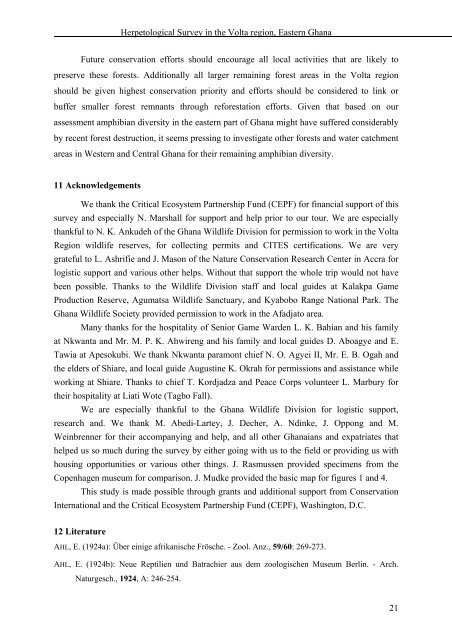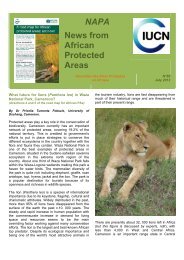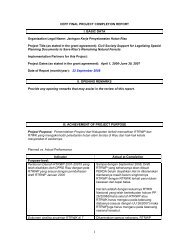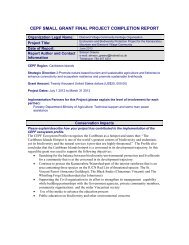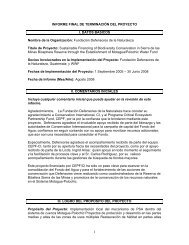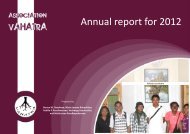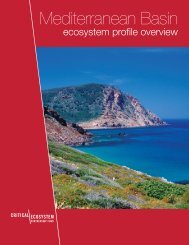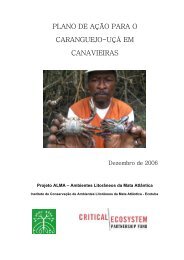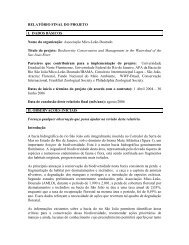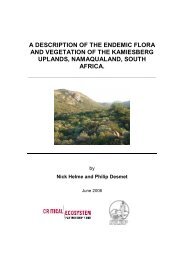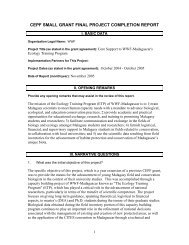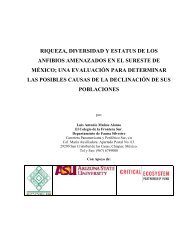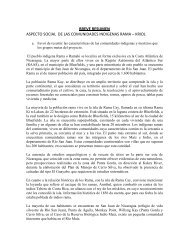Herpetological survey in the Volta region, Eastern Ghana - Critical ...
Herpetological survey in the Volta region, Eastern Ghana - Critical ...
Herpetological survey in the Volta region, Eastern Ghana - Critical ...
Create successful ePaper yourself
Turn your PDF publications into a flip-book with our unique Google optimized e-Paper software.
<strong>Herpetological</strong> Survey <strong>in</strong> <strong>the</strong> <strong>Volta</strong> <strong>region</strong>, <strong>Eastern</strong> <strong>Ghana</strong><br />
Future conservation efforts should encourage all local activities that are likely to<br />
preserve <strong>the</strong>se forests. Additionally all larger rema<strong>in</strong><strong>in</strong>g forest areas <strong>in</strong> <strong>the</strong> <strong>Volta</strong> <strong>region</strong><br />
should be given highest conservation priority and efforts should be considered to l<strong>in</strong>k or<br />
buffer smaller forest remnants through reforestation efforts. Given that based on our<br />
assessment amphibian diversity <strong>in</strong> <strong>the</strong> eastern part of <strong>Ghana</strong> might have suffered considerably<br />
by recent forest destruction, it seems press<strong>in</strong>g to <strong>in</strong>vestigate o<strong>the</strong>r forests and water catchment<br />
areas <strong>in</strong> Western and Central <strong>Ghana</strong> for <strong>the</strong>ir rema<strong>in</strong><strong>in</strong>g amphibian diversity.<br />
11 Acknowledgements<br />
We thank <strong>the</strong> <strong>Critical</strong> Ecosystem Partnership Fund (CEPF) for f<strong>in</strong>ancial support of this<br />
<strong>survey</strong> and especially N. Marshall for support and help prior to our tour. We are especially<br />
thankful to N. K. Ankudeh of <strong>the</strong> <strong>Ghana</strong> Wildlife Division for permission to work <strong>in</strong> <strong>the</strong> <strong>Volta</strong><br />
Region wildlife reserves, for collect<strong>in</strong>g permits and CITES certifications. We are very<br />
grateful to L. Ashrifie and J. Mason of <strong>the</strong> Nature Conservation Research Center <strong>in</strong> Accra for<br />
logistic support and various o<strong>the</strong>r helps. Without that support <strong>the</strong> whole trip would not have<br />
been possible. Thanks to <strong>the</strong> Wildlife Division staff and local guides at Kalakpa Game<br />
Production Reserve, Agumatsa Wildlife Sanctuary, and Kyabobo Range National Park. The<br />
<strong>Ghana</strong> Wildlife Society provided permission to work <strong>in</strong> <strong>the</strong> Afadjato area.<br />
Many thanks for <strong>the</strong> hospitality of Senior Game Warden L. K. Bahian and his family<br />
at Nkwanta and Mr. M. P. K. Ahwireng and his family and local guides D. Aboagye and E.<br />
Tawia at Apesokubi. We thank Nkwanta paramont chief N. O. Agyei II, Mr. E. B. Ogah and<br />
<strong>the</strong> elders of Shiare, and local guide August<strong>in</strong>e K. Okrah for permissions and assistance while<br />
work<strong>in</strong>g at Shiare. Thanks to chief T. Kordjadza and Peace Corps volunteer L. Marbury for<br />
<strong>the</strong>ir hospitality at Liati Wote (Tagbo Fall).<br />
We are especially thankful to <strong>the</strong> <strong>Ghana</strong> Wildlife Division for logistic support,<br />
research and. We thank M. Abedi-Lartey, J. Decher, A. Nd<strong>in</strong>ke, J. Oppong and M.<br />
We<strong>in</strong>brenner for <strong>the</strong>ir accompany<strong>in</strong>g and help, and all o<strong>the</strong>r <strong>Ghana</strong>ians and expatriates that<br />
helped us so much dur<strong>in</strong>g <strong>the</strong> <strong>survey</strong> by ei<strong>the</strong>r go<strong>in</strong>g with us to <strong>the</strong> field or provid<strong>in</strong>g us with<br />
hous<strong>in</strong>g opportunities or various o<strong>the</strong>r th<strong>in</strong>gs. J. Rasmussen provided specimens from <strong>the</strong><br />
Copenhagen museum for comparison. J. Mudke provided <strong>the</strong> basic map for figures 1 and 4.<br />
This study is made possible through grants and additional support from Conservation<br />
International and <strong>the</strong> <strong>Critical</strong> Ecosystem Partnership Fund (CEPF), Wash<strong>in</strong>gton, D.C.<br />
12 Literature<br />
AHL, E. (1924a): Über e<strong>in</strong>ige afrikanische Frösche. - Zool. Anz., 59/60: 269-273.<br />
AHL, E. (1924b): Neue Reptilien und Batrachier aus dem zoologischen Museum Berl<strong>in</strong>. - Arch.<br />
Naturgesch., 1924, A: 246-254.<br />
21


